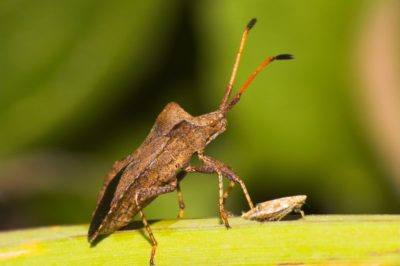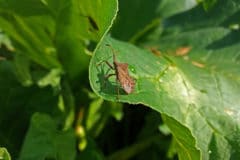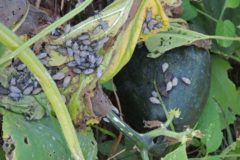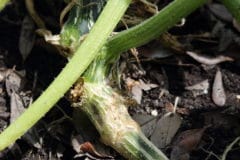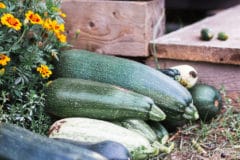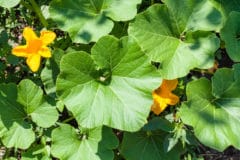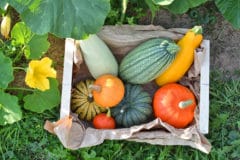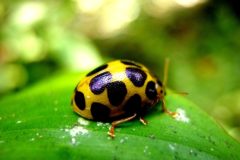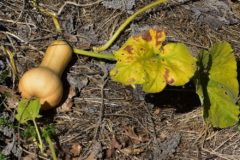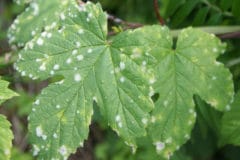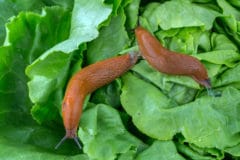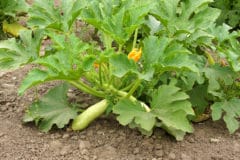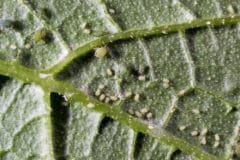Early Detection Is Key to Prevention
Knowing your enemy is the beginning of defeating any foe in war. Squash bugs are one of the enemies to a successful squash crop. Learn how to identify this pest that can be defeated.
Identifying Adult Squash Bugs
Adult squash bugs are 5/8 inch long, dark brown or gray in color, flat-backed true bugs. The edges of their abdomen have orange to orange-brown stripes. Adult bugs lay yellowish brown and bronze to brick red eggs in clusters (15-40) under leaves or on stems.
Identifying Young Squash Bugs
The young bugs (nymphs) are about 1/10 inch long and whitish-green to gray in color. The heads, legs, and antennae of the spider-like nymphs are red. As they mature, they become grayish-white with dark legs.
How to Prevent or Control Infestations
Squash bugs injecting their toxin into your beautiful squash plants can cause the plant to have yellow spots, turn brown, dry up, turn black, turn crisp, and turn brittle. Young plants could easily die before producing the first fruit. There are some preventative steps to halt or reduce the damage squash bugs do.
Use Crop Rotation
Plants in the cucurbit family (squash, pumpkins, cucumbers, melons) should not be planted in the same area of the garden two years in a row. Overwintering squash bugs have a more difficult time finding their source of food if your squash plants are located in a new location the following year.
Use the Proper Mulch
Mulching is usually beneficial, but deep and cool mulching with materials like straw or hay may not be for squash plants. Squash bugs prefer a cool, wet environment that straw and hay provide. So skip this type of mulching to discourage squash bugs.
Use Row Covers
Polyester row covers are an effective method of preventing squash bugs from attacking plants. Adult squash bugs are prevented from laying their eggs on the plant. Simply cover the young plants, making sure the row covers are tight to the ground and remain that way. To ensure pollination, remove the row covers when the first female flower opens.
Use Companion Planting
The cultivation of plants next to or very near to other plant types to aid in growth is called companion planting. These companion plants release odors that deter many garden pests including squash bugs. Here are some flowers and herbs that may control the squash bugs:
- Nasturtium
- Marigold
- Tansy
- Catnip
- Borage
Use Resistant Varieties of Squash
Squash bugs tend to prefer feasting on certain varieties of squash plants. Butternut, Royal Acorn, Black Zucchini, and Sweet Cheese are some varieties that are more resistant to the damaging effects of squash bugs.
Use Good Field Sanitation in Garden
Even gardens need good housekeeping. It is important to get rid of pest-infested or disease-ridden squash plants at the end of each growing season. Resist the temptation to compost such plant material that will only add problems to future plants. Also, remove debris that provides shelter for overwintering squash bugs.
Use Delayed Planting Tactics
Planting squash in the early summer rather than spring may decrease chances of squash bugs attacking your plants. Adult squash bugs that overwinter emerge in early spring looking for host plants. The bugs mate and lay eggs on the squash plant. If there are no host plants the squash bugs fly away or die.
Use Biological Control
The Trichopoda pennipes is a parasitic tachinid fly that lays its eggs on the underside of squash bugs. When in the maggot stage, it feeds on the squash bugs, but death to the squash bugs comes when the fly emerges. Here are some plants that attract the Trichopoda pennipes (tachinid fly):
- Alyssum
- Calendula
- Daisy
- Dill
- Fennel
- Mustard greens
Use a Trellis
Trellising the vining types of squash can make the plants less vulnerable to large populations of squash bugs. Squash bugs prefer wet locations. Using a trellis can change the environment into a drier one and deter squash bugs from conjugating.
How to Kill Squash Bugs
You have followed all the suggestions for prevention and control; however, your squash plants are infested with ferocious squash bugs. What can be done now? You don’t want to use chemicals that harm you or the beneficial insects. There are some natural ways to kill squash bugs
Hand Pick the Bugs Off
The simplest way to kill squash bugs is to hand pick them off. Drop the bugs in a container of water and liquid detergent. The bugs will die and can be disposed of. The best time to do this is in the early morning or late evening. Most squash bugs are located on the underside of the leaves or near the base of the plant.
Get Rid of Squash Bug Eggs
Getting rid of the eggs of a squash bug can greatly reduce the population of this pest that can wreak havoc on squash plants. Some gardeners carefully scrape the eggs off. Others smash them and drop them into a water and liquid detergent mixture. Another more drastic measure is to cut off the portion of the leaf that contains the eggs.
Trap and Kill the Squash Bugs
Trapping squash bugs is an easy way to kill them. On cool nights, squash bugs like to conjugate under debris to keep warm. Place a board or shingle near the plant at night. In the morning, raise up the board or shingle and smash the bugs between two hard surfaces. Two flat boards hinged together would be ideal for killing the squash bugs.
Use Diatomaceous Earth
Diatomaceous earth, ground up fossilized diatom shells, can kill the young squash bugs (nymphs), but may not be as effective on the adult bugs. The diatomaceous earth creates microscopic cuts in the exoskeleton of the squash bugs that cause them to dry up and die. Adult squash bugs have harder exoskeletons that may not be affected by the abrasive cuts.
Diatomaceous earth can be harmful to a person’s lungs. Another disadvantage of using it is that it can also kill beneficial bugs. It can be applied while a plant is growing and also when the season is over to prevent bugs from overwintering. Here are some suggestions for the use of it:
- Cover mouth and nose with mask or cloth.
- Buy and use only food grade diatomaceous earth.
- Dust bug infested area.
- Do not apply to flowers of plants.
Use Neem Oil Extract
Neem oil has three unique abilities: repels squash bugs, makes it difficult for the bugs to feed on the leaves, and limits reproduction of bugs. Neem oil is extracted from the neem tree (Azadirachta indica), native to India. Ready-to-use or concentrated forms of the oil can be purchased.
Neem oil is relatively safe, but there are a few precautions to follow. It can cause irritation to skin, eyes, or other exposed areas. Wear goggles and long sleeves when applying. If neem oil is swallowed it can cause stomach upset. Pets and children should stay away from sprayed areas until it is completely dry.
Application of neem oil should be done in the early morning or late evening. If using the concentrated form of neem oil, one fluid ounce of oil to a gallon of water is the usual formula for effective bug killing. Saturate the affected areas of the plant with the oil mixture avoiding bees and beneficial bugs. Repeat every seven days.
Use Sabadilla
Sabadilla, one of the least toxic natural pesticides, is derived from Sabadilla lily seeds. Squash bugs are killed through direct contact and through stomach poisoning when the sabadilla powder is ingested. When applying wear long-sleeved shirt, gloves, and a mask covering the mouth and nose.
Use Rotenone
The roots of the derris and the cube plants growing in Asia and South America are the sources for rotenone. It is moderately toxic to mammals, but washes off plants easily and does not leave a residue. When applying rotenone, always use a face mask to protect your airways.
Use Insecticidal Soap
Insecticidal soap is effective at killing squash bugs without harming birds or hard-bodied beneficial insects. Begin spraying entire plant thoroughly when squash bugs first appear. Continue to spray every three days for about two weeks. Follow manufacturer’s label for the correct amount to use.
